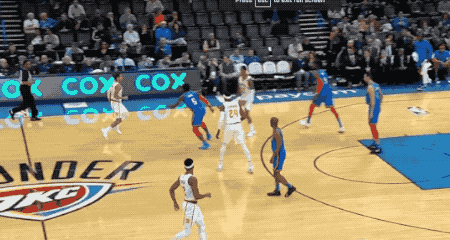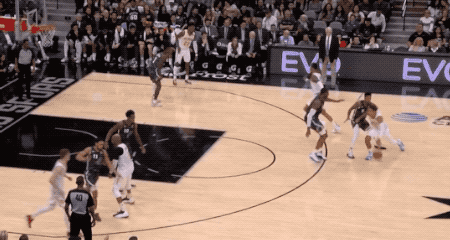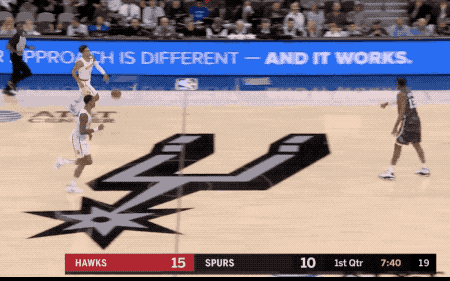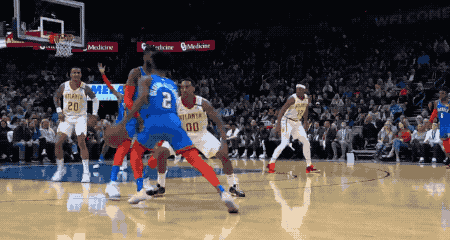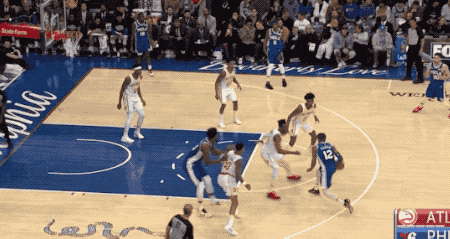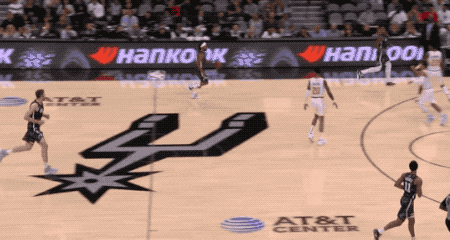More talent, more problems
John Collins, the Atlanta Hawks, and the not-so-simple art of converting gaudy individual stats into winning plays.
This is from the newest Mandalorian episode, which you should watch immediately if you haven’t yet. I hope these screenshots didn’t spoil it for you.
Did you know that John Collins averaged 20 points and 10 rebounds per game while making 40 percent of his threes? Maybe you did, but I doubt it unless you’re an Atlanta Hawks fan. I had to double-check to make sure my eyes weren’t deceiving me.
What explains Collins’ relative anonymity? Well, he missed 25 games due to a drug suspension, and the Hawks were miles from the playoff picture once he returned. He hasn’t played a game in nine months due to *gestures at the world.* He’s a play finisher in a league tailored to play initiators. His personality is understated. He wasn’t highly recruited, nor was he a lottery pick. He’s not Trae Young, who sucks up all the Hawks oxygen for better or worse. His name is John Collins, which doesn’t sound like a cool NBA player. (I’m only half-kidding on this point).
Mostly, though, Collins was anonymous because his impressive stat line hasn’t made much of an impact in the win column. He yearns to be a versatile, positionless modern big, but that requires more skills than running, jumping, and (as of last year) shooting. Those traits have enabled Collins to produce points and rebounds for himself, but they didn’t draw double teams, weren’t useful in making plays for others, and haven’t been applied to effectively defend the basket or in space. They’ve also done little to clarify his position, solidify his role, or provide a clear roadmap for his future on a team that’s actually trying to win. What good is 20 and 10 if that production is this pointless?
The obvious counter is that Collins’ play only seemed pointless because the Hawks’ roster sucked. How can one say he doesn’t impact winning when his team’s talent never gave him a chance? Are those who dismiss Collins’ numbers simply falling for the Horn Effect? Are they doing the thing Suns fans accused many of doing with Devin Booker before last year and assuming a productive player on a horrible team must be causing their plight?
We’re about to find out. Spurred by an ownership-level mandate to compete now, the Hawks went on an offseason spending spree that dramatically upgraded their roster on paper. They’re playing for something now, which could either illuminate Collins’ versatility or shine a harsh light on his limitations. Is his game inherently empty calories, or did it only appear that way because his team’s dire state made it impossible to produce anything else?
The answer to that question has significant implications for Collins’ career, the Hawks, and the league as a whole. If Collins successfully scales his production to blend with and even enhance his more talented teammates, he will cement himself as a pillar of the next great Hawks team. If he can’t, he will lose minutes to and perhaps get displaced entirely by incoming veterans at both of his potential positions. He could begin to capitalize on his promise to be the do-everything “positionless” big man every next-generation great team needs, or he could end up as a tweenter who’s not really a 4 and too small to be a 5.
Success for Collins this season won’t be measured by his individual production. So how can we tell if he’s providing essential nutrients that help the Hawks win meaningful games?
1. His shooting improvement is real
Let’s start with some good news. That 40 percent from three on increased volume? That was no fluke.
From the day he entered the league, Collins showed he could be a devastating rim-roller. He possesses a rare combination of springy feet and soft hands, making him equally effective finishing lobs and pocket passes. He’s also nimble in space, with quick-twitch muscles that allow him to maneuver side-to-side as well as vertically.
Of course, the modern game doesn’t allow for any player to roll to the hoop the same way each time, especially one who’s undersized for a center. If Collins wanted to touch the ball consistently, he needed to become a threat on the perimeter. That required popping into open space when the lane was clogged and trusting that his point guard could draw the attention his roll otherwise would. It also required Collins to get his in-game shooting mechanics down. There was little doubt that he could shoot threes, but making them in practice and hitting them in a game setting are two entirely different things.
Why’s that? A jump shot is a fluid motion that requires the body to be in sync from catch to release. Hesitation throws the entire operation off, as does a lack of balance at any point in the motion. Players who yearn to become better in-game shooters need to correct those imbalances and commit their up-and-down motion to precise muscle memory. That takes time and practice.
On top of that, in-game shooting is challenging because players can’t script exactly how they receive the ball. Shooters catch passes at different spots on the floor with wide-ranging body positions. The pass might be up high, down low, to the left, or to the right. It could be lobbed, bounced from the floor, or rifled as hard as possible. There’s rarely time to realign one’s shoulders, chest, or feet before the defenders close out.
Because of all those factors, it’s not practical for players to catch the ball and then decide to shoot. They must make the decision before they even catch the pass. Only then are they able to seamlessly connect the “catch” part to the “shoot” part without creating even more friction that would throw off the shooting motion.
Collins’ long-range marksmanship last year is directly tied to his improvement in this area. He has trained himself to waste little time between the “catch” part and the “shoot” part, turning it into one smooth process when it was choppy before. It’s no coincidence that his three-point percentage on catch-and-shoot opportunities rose from 35.3 percent in 2018-19 to 42.5 percent last year.
Better yet, he can apply the same principles no matter his foot position. Some guys are “hop” shooters who need that up-and-down movement to generate power and elasticity. Others prefer to step into shots because that gives them forward momentum. It’s fine for players to have a preference, but it also helps if they can do both.
Collins can do both. Here he is one-two stepping into a three.
Here he is taking a small hop to generate more power into the shot.
He seems to have shooting versatility, so he can be useful to his team even when he’s not actively involved in a ball screen. He can slide into open space along the perimeter and still hop effectively into spot-up threes without sacrificing his shooting mechanics. The more Collins does that, the more he can take a backseat and play off other guys running pick-and-roll with Young, Bogdan Bogdanovic, Rajon Rondo, or whoever.
Shooting percentages can fluctuate year to year, so Collins might not be all the way up at 40 percent again. But he’s undoubtedly established himself as a threat defenses must honor, which will open more space for his teammates. That’s encouraging.
2. He learns to make good decisions for teammates on the move
Now, the bad news.
Collins is a very good player when he’s given time to stop and perform a specific duty in a pick-and-roll. He doesn’t always make contact with defenders on his screens, but he has an excellent sense of when he’s able to pivot and slip to the rim effectively, thereby drawing attention away from the ball-handler.
He’s also good at flipping his screen to the other side and catching the defense off guard to free Young for long bombs.
We know about his finishing ability on the move. We’ve established that he is becoming a terrific pick-and-pop shooter. All that is good news …
… if every single Hawks possession starts with a Young/Collins high pick-and-roll and ends with one of the two scoring. Alas, that’s not how basketball works.
Offenses need players to make the right decision within the flow of a possession. No coach alive can script every sequence. Every possession has infinite alternative possibilities that players must dissect and act on in an instant.
This is where Collins’ game falls shortest in more ways than one.
For starters, he’s a poor passer for his position, dishing out only 1.5 assists to 1.8 turnovers last season. He has serious tunnel vision when diving down the lane, electing to score difficult shots himself instead of making the simple kickout or dump-off pass.
When he does manage to spot the open man, it’s usually a beat too late. At worst, he throws passes to nobody.
But there are many more potential easy buckets that disintegrate when Collins’ hesitation closes the opening. Friend of the newsletter Nate Duncan coined the term “record scratch” to describe when a player fails to make an instant shoot-pass-or-drive decision. It’s as if they’ve stopped the music for a second, hence “record scratch.”
Duncan often uses the term to describe non-shooting wings that won’t take open spot-up jumpers, but the same concept applies to big men who read the help too slowly when rolling to the basket. When he’s not able to catch and finish himself, Collins often becomes be a record-scratcher. His hesitation reading Bruce Brown allows Andre Drummond to recover in this pick-and-roll.
And his slow kickout pass to the corner turns Kevin Huerter’s open corner three into a tougher off-the-dribble floater.
Passing has never been Collins’ strong suit. He notched just 17 assists all season in his final year at Wake Forest, which was about one every two games. He perked up a bit in this area in 2018-19, but regressed last year. It’s hard to be an effective big man in 2020 without any playmaking skill on the move, much less one that transcends positional rigidity.
Actual passing in flow situations is just one of Collins’ issues, though. He’s an awful screener in any non pick-and-roll situation and a sloppy ball-handler when executing dribble handoffs. To diversify their offense, the Hawks need Collins, at a minimum, to be able to spring their non-Trae Young perimeter players free when they curl into ball screens on the move. He’s shown little ability to do that effectively outside of some scripted after-timeout plays.
Sometimes, he fails to divert the primary defender’s path, which allows them to deny the ball.
Sometimes, he slips too early.
Sometimes, the “dribble” part of the handoff is remarkably casual.
Sometimes, Collins fails to reposition his body to react to the defense’s strategy and gets shoved off his spot. He flips screens well in stationary pick-and-rolls, but finds it a lot harder with dribble handoffs.
This weakness becomes more glaring as a team adds more perimeter shot creators. It’s hard to run a free-flowing multi-pronged offense without a skilled frontcourt player capable of connecting two sequences together. Young is often blamed for hogging the ball to run a zillion high pick-and-rolls, but he can’t be one sequence’s initiator, another sequence’s finisher, and the guy connecting the two at the same time. If the Hawks want to make their offense more democratic, they need Collins to become far better at cycling the ball from one side to the other.
There’s one more issue, too. While Collins is excellent rolling hard to the basket, he is not the best at recognizing when he needs to pause his roll to be an outlet for Young on traps. This is known as the “short roll,” and it’s become an essential skill for any big man in the modern game. It’s the counter for teams aggressively jumping out to stop guards from launching long threes, as Trae is known to do.
How does a big man know when to dive hard and when to sit down in the short-roll pocket? It requires anticipating the defense’s coverage plan and making a quick read to defeat it. It’s more art than science.
And it’s never been Collins’ strength. Too often, he leaves Young out to dry by rolling hard on a trap when he should be rolling short.
These flaws have two common denominators: a lack of feel and an inability to process the full geometry of the court. What good are Collins’ many athletic qualities if he can’t access them fast enough? That’s why he often looks like a passenger in his own body instead of an active participant.
The good news is that Collins will become more confident with his decision-making as he gains more experience. He seems like a hard worker, both in the film room and on the practice floor. He’s also aware of his flaws, which is better than not being aware of them. But he has a loooong way to go before I feel confident saying he’ll reliably grease the wheels for his teammates.
His learning curve will get a whole lot steeper. The nice thing about having better teammates is that they are better at basketball. The challenge is that they also possess a wider array of skills to stitch together. Collins will have more options flying at him on a possession-by-possession basis, and that’s not ideal for someone who already struggles with on-court sensory overload.
3. He learns to stay down on defense
In an interview ESPN’s Zach Lowe in the summer of 2019, Collins described the exact cause of his defensive issues: bad technique.
“Getting low,” he said when asked what coaches get on him the most for failing to do. “Being in a stance. Being in a stance all the time is f***ing tough. You have to be truly in shape.”
Zach was blown away, and so was I when I heard it. It’s a remarkably specific and astute admission that you rarely hear publicly. Right off the bat, that’s a great sign.
Of course, knowing the problem and changing it are two entirely different things. Collins may have identified his biggest defensive weakness, but he didn’t apply that knowledge all that well last season. He was up in his stance constantly last season and it cost him dearly.
It prevented him from effectively defend perimeter players and big men, much less one or the other. The former group gets him on his heels too often in space. Watch him come up in his stance as Shai Gilgeous-Alexander comes at him.
The latter group pushes him around too much.
It slowed him down when trying to help at the rim. Collins is a bit slight, but the bigger issue is that he makes himself smaller by not getting his body in position before jumping. We’re gonna slow this clip down so you can see how he reacts a split second too late and fails to come up high enough to stop Danilo Gallinari’s Eurostep.
Collins is also prone to mental lapses off the ball, which often take the form of needless or botched switches.
Sounds bad, right? Getting low is kinda important to playing good defense, and it’s confusing that an athletic wonder like Collins struggles in this regard.
Spun another way, though, and there’s some cause for optimism. It shows Collins is capable of defending effectively. He just has to do it more often.
Honestly, Collins showcased some impressive mobility when he was able to stay down in his stance. It’s not easy to contain the ball and rotate over to stone the roller like this.
Nor is it easy to front LaMarcus Aldridge multiple times and react to his moves in the mid-post.
Nor is it easy to stay in front of DeVonte Graham on a switch after playing 45 minutes in a double-overtime game.
Collins has also improved his verticality, at least when he’s put himself in position to go straight up. While he could stand to build more strength, he’s begun effectively using his long arms and springy legs to meet drivers at the summit without fouling.
These are promising signs of defensive versatility, even if they only occur when he has time to crouch. The Hawks were 2.6 points better per 100 possessions on defense with Collins on the floor, allowed slightly fewer shot attempts at the rim, and surrendered many more from mid-range. Those were all improvements on past seasons, so at least Collins is trending up.
That reaction time must improve, and it’s troubling that it resembles the same lack of feel Collins has on offense. But I’m more optimistic that Collins can become a higher-impact team defender because the fix is so obvious. If he can just stay low all the time, he can cover lots of ground quickly. He doesn’t need to cover that ground while also making an instant shoot-pass-dribble-etc. decision. He just needs to cover the ground.
We’ve seen him do that when he’s able to get down in a stance. He knows he’s bad at staying down all the time. Connecting those two is the trick, and it’s not going to be easy. But at least the tools are there.
Aren’t you overthinking this? Why are you nitpicking John Collins so much?
I realize I sound like a killjoy to Hawks fans enamored by Collins’ potential. It’s easy to look at a then-22-year-old putting up a 20-10 line on 40 percent from three and assume further improvement is inevitable. It’s also easy to give Collins extra credit for putting up those numbers on a crappy team.
But those gaudy stats don’t necessarily translate to the complementary skills that good teams need to get more out of the sum of their parts. Basketball is not a game of addition. Teams need points to satiate their hunger, but they also need a steady dose of healthy side dishes to keep the collective functioning at a high enough level to get the most out of their talent.
The Hawks have spent the last three years consuming calories with little regard to their overall health. It’s not easy for players to produce under those circumstances, but it’s an entirely different challenge than functioning as a part of a healthy, winning mix. Their offseason conveys they’re ready to take their diet more seriously.
So is John Collins a high-calorie snack, or a healthy vegetable? We’re about to find out.











